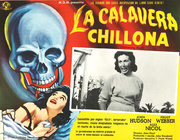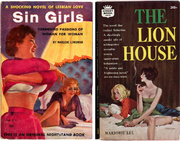
In the 1960s and ’70s, tens of millions of eyeballs a month looked forward to the latest surreal compositions on the covers of Mexican pulp fiction. Unlike their counterparts in the United States, where depictions of steamy sex and the promise of somewhat-porny scandal sold best, pulp-fiction covers south of the border usually relied on bizarre visual scenarios, whose WTF weirdness was more important than their overt sexuality—although there was usually plenty of that.
Take the covers now on view in their original tempera-on-board form at the Ricco/Maresca gallery in New York. In one illustration (all have blank areas near the top for the publication’s title), a woman flees a police officer while cradling a baby pig. In another, a photographer is inexplicably freaking out by the presence of a leggy calendar girl. And then there’s the cover featuring what appears to be a hotel maid, who has walked into a room only to discover a buxom blond collapsed on the floor, surrounded by green, pointy-eared creatures of Lilliputian height—aliens, no doubt.
A close cousin of Mexican B-movie lobby cards, Mexican pulps were typically illustrated on their inside pages like American comic books or Japanese manga. The text was often hand-lettered in speech bubbles, telling stories similar to old-fashioned folk or morality tales. The protagonists were almost always ordinary people (not coincidentally, the target audience of these publications) caught in fantastical scenarios that might contain elements of science fiction, Westerns, horror, crime, and the paranormal.
American pulps were generally the same dimensions as other paperback titles, but Mexican pulps were usually much smaller in size, often just 2 inches wide by 3 inches tall—that’s why they were called micro-cuentos or “mini-tales.” In contrast, the source illustrations on view at Ricco/Maresca are roughly 11 x 15 inches ($2,200) and 14 x 19 inches ($2,500). While some of these lurid, pulp masterpieces bear the signatures of artists named Delgadillo, Dorantes, Hezez, Rarly, Roberto, and Zavala, most are unsigned, their creators lost to the brutal crush of eight-day production cycles.
(“Pulp Drunk: Mexican Pulp Art” was presented in 2015 at Ricco/Maresca in New York. To learn more about this art form, order a copy of Mexican Pulp Art, which features pieces from the collections of Bobbette Axelrod and Ted Frankel. If you buy something through a link in this article, Collectors Weekly may get a share of the sale. Learn more.)













 Return to 'The Crypt': Jack Davis Resurrects the Crypt-Keeper
Return to 'The Crypt': Jack Davis Resurrects the Crypt-Keeper
 Sex! Gore! Scary Monsters! Attack of the Mexican B-Movie Ads
Sex! Gore! Scary Monsters! Attack of the Mexican B-Movie Ads Return to 'The Crypt': Jack Davis Resurrects the Crypt-Keeper
Return to 'The Crypt': Jack Davis Resurrects the Crypt-Keeper When Being a Lesbian Was Profitable, For Men
When Being a Lesbian Was Profitable, For Men Paperback BooksWhen the Beatles’ “Paperback Writer” hit number one in 1966, fans everywher…
Paperback BooksWhen the Beatles’ “Paperback Writer” hit number one in 1966, fans everywher… PaintingsFor centuries, painting has been the primary medium of fine art, creating t…
PaintingsFor centuries, painting has been the primary medium of fine art, creating t… BooksThere's a richness to antique books that transcends their status as one of …
BooksThere's a richness to antique books that transcends their status as one of … Mari Tepper: Laying it on the Line
Mari Tepper: Laying it on the Line Nice Ice: Valerie Hammond on the Genteel Charm of Vintage Canadian Costume Jewelry
Nice Ice: Valerie Hammond on the Genteel Charm of Vintage Canadian Costume Jewelry How Jim Heimann Got Crazy for California Architecture
How Jim Heimann Got Crazy for California Architecture Modernist Man: Jock Peters May Be the Most Influential Architect You've Never Heard Of
Modernist Man: Jock Peters May Be the Most Influential Architect You've Never Heard Of Meet Cute: Were Kokeshi Dolls the Models for Hello Kitty, Pokemon, and Be@rbrick?
Meet Cute: Were Kokeshi Dolls the Models for Hello Kitty, Pokemon, and Be@rbrick? When the King of Comedy Posters Set His Surreal Sights on the World of Rock 'n' Roll
When the King of Comedy Posters Set His Surreal Sights on the World of Rock 'n' Roll How One Artist Makes New Art From Old Coloring Books and Found Photos
How One Artist Makes New Art From Old Coloring Books and Found Photos Say Cheese! How Bad Photography Has Changed Our Definition of Good Pictures
Say Cheese! How Bad Photography Has Changed Our Definition of Good Pictures Middle Earthenware: One Family's Quest to Reclaim Its Place in British Pottery History
Middle Earthenware: One Family's Quest to Reclaim Its Place in British Pottery History Fancy Fowl: How an Evil Sea Captain and a Beloved Queen Made the World Crave KFC
Fancy Fowl: How an Evil Sea Captain and a Beloved Queen Made the World Crave KFC
Those are cool drawings!